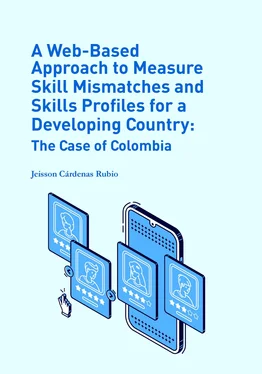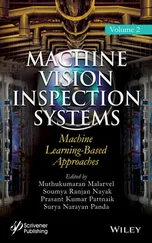In 2015, the SENA surveyed both employees and employers in order to create employability, performance, and relevance indices of its vocational programs. The SENA sought to evaluate the skills performance of its graduates, such as communication, adaptation to changes, responsibility, teamwork, among others. Around 4,502 people were interviewed, who graduated from the institution in the second semester of 2013 and in the first semester of 2014, in addition to employers who hired those graduates (SENA 2015). The survey attempted to evaluate the content of vocational programs by measuring skills performance in people’s jobs. However, even for that purpose, the results of these surveys are limited. Indeed, they are representative of only 13% of the total number of vocational programmes (SENA 2015), and employers were not asked about their skill requirements to fill vacancies. Moreover, information from the SENA (microdata) is not available to the public.
Thus, in Colombia, the main sources of information used in the analysis of labour demand have come from sectorial (entrepreneur) surveys or household surveys. These data have certain strengths, such as national standardisation and global representativeness, but the collection of labour demand information through surveys is limited, since it can be quite costly, both in terms of resources and time. Above all, these sources might not provide enough detailed information about what skills (or occupations) are in demand among different industries or regions (Handel 2012; OECD 2016b).
In 2013, a Colombian law 36established that all job portals and companies must report their vacancies to the Unidad Administrativa Especial del Servicio Público de Empleo (UAESPE, for its acronym in Spanish). Thus, potentially, the UAESPE can provide a vacancy data analysis for Colombia. However, the UAESPE approach has different limitations that affect the robustness of vacancy analysis. First, job portals and companies do not report all the information that describes a vacancy to the UAESPE. There is a predefined format that companies and job portals complete with certain information that partially describes the vacancy. Second, the UAESPE does not know whether companies report the total number of vacancies available. For instance, employers might underreport the number of vacancies because it might be time-consuming to fill and send all the information to the UAESPE. Moreover, the UAESPE does not have a methodology to systematically verify that employers have reported the total number of job vacancies advertised. Third, the inclusion or exclusion of some employers or job portals over time might affect the vacancy time series. An increase in the number of vacancies might be due to the inclusion of a new job portal (with not necessarily different and new vacancies). Fourth, as will be discussed in more detail in Chapters 4and 5, the problem of duplication increases by adding more websites. The UAESPE collects information from different job portals and employers. However, a job vacancy can be published on various websites. Given that employers are not required to report full vacancy details, it is more difficult for the UAESPE to determine whether a vacancy is duplicated. Finally, the database and the UAESPE methodology to compile, clean, and classify vacancies are not available; hence, the vacancy analysis conducted by this institution lacks robustness.
These problems have made employer requirements or vacancy information scarce (Allen, Levels and Velden 2013). As Álvarez and Hofstetter (2014) mention, vacancy data to study the labour market are scarce in developing countries like Colombia. As a result, the human resource needs of the country have remained unknown until the present study. As a consequence, Colombia lacks a human capital formation system with accurate tools (among other instructional agreements) to address public policy, education and job training programs. So far, these aspects have remained unaddressed and have not been aligned with the employers’ needs; instead, a low-quality education has proliferated. For instance, in 2013, only 4% of 1,576 technological training programs, and 3% of 740 professional technical training programs offered by private institutions were accredited (considering content and infrastructure, among other characteristics) in terms of quality by the Ministry of Education (González-Velosa and Rosas-Shady 2016). Likewise, the Regional Centres of Higher Education (CERES for its acronym in Spanish) have been reported to teach their students with outdated technologies and at an insufficient educational quality level (OECD 2016b). Given the low standards of training and education quality, even the Technical and Vocational Education and Training (TVET) system has not grown enough in the last few years due to lost prestige (OECD 2015b).
Given these facts, it has become necessary to seek new and novel ways to assess the labour supply needed by companies. One promising approach to address this issue is the provision and analysis of detailed labour demand information using Big Data techniques. As will be discussed in the following chapter, building a web-based model of skill mismatches (skill shortages) for Colombia (and potentially for its regional counterparts) might have a large impact, considering its potential use as a public policy tool related to a better management of human resources (i.e. the reduction of informality and unemployment rates), and also to assist in the allocation of skill development and educational budgets.
3.6. Conclusion
Despite the socio-economic improvements of the last decades, the Colombian labour market faces important challenges. The proportion of people participating in the labour market has considerably increased since 2008. Therefore, the labour market needs to 1) engage new job seekers into the formal economy, 2) retain workers in the formal economy, and 3) move informal workers into the formal sector.
While other countries have created systems with statistical tools in order to measure skill mismatches and, thus, orientate public policies that seek to decrease this phenomenon, different barriers might prevent the pursuit of that goal in Colombia. According to the evidence presented in this chapter, skill mismatches are one of the most important barriers to reduce unemployment and to increase employment in the formal sector; consequently, skill mismatches might explain the high incidence of informality and unemployment in Colombia. A revision of the most important sources of information regarding human capital in the country shows that 1) available information sources are aggregated at levels that do not enable a detailed knowledge of existing occupations or skills; 2) there are difficulties in updating surveys or classifications (e.g. SOC 1970); 3) there are representation problems in the data gathering process (e.g. limited sample sizes), and 4) no information sources collect employer vacancy requirements. Thus, the available data indicate that there is a skill mismatch problem, which means that it is not possible to know in enough detail what skills are needed in the Colombian labour market.
The above analysis, in combination with institutional efforts, evidences the interest of Colombia in measuring and tackling skill mismatches. However, the absence of an accurate tool to measure the multiple dimensions of human capital, together with an institutional disarticulation, is one of the most critical factors that complicate the design of public policies, policies that need to be well-oriented in order to reduce the skill mismatch phenomenon in the country. Thus, a web-based model of skill shortages might provide valuable information for policymakers about employer requirements and might connect various efforts made by different institutions regarding skill mismatch analyses.
Конец ознакомительного фрагмента.
Читать дальше












